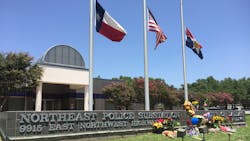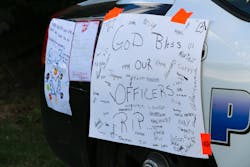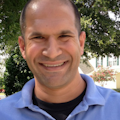Preventing Officer Fatalities and Coping With Tragedy
David Brown, who was sworn in a Chicago Police Superintendent in April 2020, was the police chief in Dallas at the time of the shooting. “One of the things I remember the most clearly after July 7 were just how much we had to respond to people who simply weren’t OK,” he recalled during a recent discussion held by the National Law Enforcement Memorial and Museum on how to prevent firearms-related deaths of officers. “I think one of the things that we did well—and that I’m proud of—is that we really made it OK for the people to not be OK in the days after something like that.”
Dr. Alex Eastman, a Senior Medical Officer with the U.S. Department of Homeland Security since 2018, who also serves as a lieutenant and lead medical officer with the Dallas Police Department, was part of the SWAT team that responded to the July 7 ambush. He also was a trauma surgeon at Parkland Hospital where multiple officers injured in the ambush were treated and was in the rare position of reporting to hospital the morning after the ambush to help care for the wounded officers. Eastman recently received the Dallas Police Department’s Medal of Valor for his actions during and after the ambush.
“One of the things that I was struck by after July 7 was how we go back and process critical incidents,” says Eastman while looking back on the aftermath of the incident. “When you have a law enforcement fatality, it profoundly affects far more people than are involved in the actual incident.”
Both men shared their thoughts during the discussion on how to prevent further firearms-related deaths of officers as part of a Destination Zero series held after the release of the 2020 Law Enforcement Officers Fatalities Report. Firearms fatalities have historically been one of the leading causes of line of duty deaths, claiming the lives of 528 officers over the last decade (2010-2019), according to data compiled by the National Law Enforcement Officers Foundation. In 2020, an additional 48 officers were shot and killed in firearms-related incidents.
Dealing with the aftermath
Brown says that he had a lot to learn when it came to managing the mental toll that the deadly ambush took on his department. “People have these misgivings about what they did. Did they do enough they can do? Cops are really hard on themselves; they really are. For them to be well, they need a path to being able to say ‘I need to talk to a peer or professional,’” he says. “That needs to be an open offering with no stigma attached to it. We want our officers to be OK on the other end of this. We want them well for their careers, but we want them well for their families as much as we want to them to come back to work.”
An after action or debriefing can benefit those involved by serving as therapy as well as improving tactics and training. “Most of the time we all have nightmares and are reliving and thinking about what we could have done better,” Brown says. “You’re second-guessing yourself.”
He pointed out that while efforts taken by a department to review an incident can improve response times and officer safety, there may be some pushback. “You’ve got to start with we can always improve. You can’t think about ‘I don’t want to critique what we’ve done because of civil litigation or because I’m afraid internal affairs is going to suspend me because I didn’t do something right.’ You’ve got to look at after actions and debriefs as No. 1, therapy for those involved but also, more importantly, this can improve training and tactics, which will lead to officer safety.”
Having attorneys involved in the after-action process can help protect a department from litigation and internal affairs because they have a role to play in looking at and sharing what could have been done better. Brown says they also add a layer of privilege that overcomes FOIA and other obstacles to obtaining to a clean critique that benefits the organization and everyone involved so everyone can be safer the next time they deal with it.
Training to de-escalate situations
Both officials spoke of the need for agencies to train officers in de-escalation in order to slow a situation down. Brown compared the mentality of some officers to the Wild West and the quick draw. “It’s the fastest out of the holster, that’s who wins. If you’re slow out of the holster, you get shot and killed. That’s the worst-case scenario, he says. “You never want to put yourself in a quick-draw scenario where the fastest draw wins. A lot of dynamics can happen where you’re at the wrong end of that draw.”
Brown stressed that officers instead need to give themselves enough time and distance to make decisions. With most high-profile deadly force encounters being captured on tape that is then edited, he says that it is crucial for officers to give themselves enough time to make the right decision. “The more time you take in resolving these deadly force encounters, the more likelihood of your surviving,” says Brown. “Slowing things down, creating time and distance creates a higher probability that you will survive that deadly force encounter because you have time for cover, you have time to get officers there to assist you, you have time to talk people out of doing what they are trying to do.”
While officers on the street need to give themselves distance, Brown says that the same goes for those in leadership positions. He notes that leaders often make the wrong decision because they are rushed for political reasons or they are rushed because they haven’t dealt with that type of scenario and they don’t know that with just a few more minutes of time, that they will likely make a different decision.
Countering ‘Defund the Police’
Brown, who joined the Chicago Police Department in the midst of the COVID-19 pandemic last year, says that going from Dallas to Chicago has been quite a transition. “My first week we buried three officers who died of COVID-19. The impact reverberated throughout the organization. It’s been a chilling effect on officers who are brave and courageous but don’t want to take something back home to their families. Officers often draw the line when it comes to their families. They are willing to risk their own lives, but don’t want to bring COVID-19 home to their families.”
One month later, George Floyd was killed during a confrontation with Minneapolis police officers and a video that subsequently shared on social media triggered outrage that across the country and was followed by calls to strip law enforcement agencies of their funding. “So much of what we’ve talked about this year in law enforcement has been how we respond and how we regain our legitimacy with communities. I think that when you hear the cry to ‘defund’ the police—a rallying cry we’ve all heard loud and clear and many places have seen and felt—when you get down to talking about what you need to effectively manage a big department, or a little department for that matter, you need money to train and do all sorts of things.”
Brown says that the initial “defund the police” discussion was, as he describes it, “a pendulum swing that went too far.” He says that the current conversation has swung back more toward the middle and that cities that followed the narrative early on through budget cuts have deep regrets for doing so. Brown stresses that cities must build up social service networks and resources while still funding the police. “Who will take the 11,000 guns off the street that Chicago police officers have taken off the streets this year? Social services can’t do that. When you have extraordinary gun violence, we can’t put social service workers in harm’s way to do their great work. There’s a role for police, there’s a role for social service workers and thank God the pendulum has swung back more toward a sensible discussion about this.”
Recently Fallen Heroes
Here are just some of the brave officers who made the ultimate sacrifice in the month of February 2021:
Lieutenant Michael Boutte
Hancock County (MS) Sheriff’s Office
End of Watch: February 1, 2021
Lieutenant Michael Boutte was shot and killed after responding to a home and was shot by someone at the property. Another responding deputy arrived on scene and shot and wounded the suspect. Lieutenant Boutte was transported to the hospital where he succumbed to his injuries.
Special Agent Daniel Alfin
U.S. Federal Bureau of Investigation
End of Watch: February 2, 2021
Special Agent Daniel Alfin was shot and killed while executing a federal search warrant involving violent crimes against children in Sunrise, Florida.
Special Agent Laura Schwartzenberger
U.S. Federal Bureau of Investigation
End of Watch: February 2, 2021
Special Agent Laura Schwartzenberger was shot and killed while executing a federal search warrant involving violent crimes against children in Sunrise, Florida.
Police Officer Darian Jarrott
New Mexico (NM) State Police
End of Watch: February 4, 2021
Police Officer Darian Jarrot was shot and killed during a traffic stop while assisting Homeland Security Investigations. The suspect shot Officer Jarrot after being pulled over and was later killed by responding officers.
Police Officer Mitchell Penton
Dallas (TX) Police Department
End of Watch: February 13, 2021
Police Officer Mitchell Penton was struck and killed by an intoxicated driver who was traveling at a high rate of speed as Officer Penton was directing traffic from a previous vehicle crash. Officer Penton was transported to the hospital where he succumbed to his injuries.
Deputy Sheriff Michael Magli
Pinellas County (FL) Sheriff’s Office
End of Watch: February 17, 2021
Deputy Sheriff Michael Magli was struck and killed by a drunk driver, who was fleeing police, as he was deploying stop sticks.
Information from the National Law Enforcement Officers Memorial Fund
About the Author
Paul Peluso
Editor
Paul Peluso is the Managing Editor of OFFICER Magazine and has been with the Officer Media Group since 2006. He began as an Associate Editor, writing and editing content for Officer.com. Previously, Paul worked as a reporter for several newspapers in the suburbs of Baltimore, MD.


